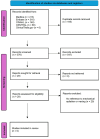The effectiveness of waxing or epilation compared to conventional methods of hair removal in reducing the incidence of surgical site infections: a systematic review and meta-analysis
- PMID: 39713809
- PMCID: PMC11659287
- DOI: 10.3389/fsurg.2024.1395681
The effectiveness of waxing or epilation compared to conventional methods of hair removal in reducing the incidence of surgical site infections: a systematic review and meta-analysis
Abstract
Background: Surgical site infections (SSIs) pose a significant challenge to healthcare systems by elevating patient morbidity and mortality and driving up financial costs. Preoperative skin preparation is crucial for preventing SSIs; however, certain traditional methods of hair removal have been found to increase the risk of SSI development. Mechanical epilation and waxing constitute two relatively explored methods of hair removal, which may hold potential to accelerate wound healing due to the activation of stem cells within hair follicles. This review assesses the efficacy of preoperative hair removal via waxing and mechanical epilation in reducing SSI incidence.
Methods: This systematic review was prospectively registered with PROSPERO (ref: CRD42023423798) and a protocol previously published in a peer-reviewed journal. All findings are reported according to PRISMA guidelines. A comprehensive search of Medline, Embase, CENTRAL, ClinicalTrials.gov and CINAHL. Inclusion criteria encompassed adult patients undergoing any surgical procedure, comparing waxing or epilation against other hair removal methods or no hair removal, with SSI incidence as the primary outcome. There was no restriction on study size or quality to ensure a comprehensive literature evaluation.
Results: The review found no studies meeting the selection criteria out of 576 records screened.
Discussion/conclusion: This review has identified no literature regarding the use of waxing and mechanical epilation as methods of preoperative hair removal. The lack of experimental evidence combined with the potential physiological advantages of these techniques indicate that this could be a valuable area of future research. These techniques may represent novel approaches to SSI prevention, particularly beneficial in high-risk surgical disciplines like vascular surgery.
Systematic review registration: https://www.crd.york.ac.uk/prospero/display_record.php?RecordID=423798, PROSPERO (CRD42023423798).
Keywords: epilation; hair removal; surgical site infection; systematic review; waxing.
© 2024 Cutteridge, Garrido, Staniland, Lim, Totty, Lathan, Smith and Chetter.
Conflict of interest statement
The authors declare that the research was conducted in the absence of any commercial or financial relationships that could be construed as a potential conflict of interest.
References
-
- CDC. Surgical site infection event (SSI) (2024). Available online at: https://www.cdc.gov/nhsn/pdfs/pscmanual/9pscssicurrent.pdf (accessed March 01, 2024).
Publication types
LinkOut - more resources
Full Text Sources


